Play it, Massimo! – An interview with the world’s most musically oriented chef
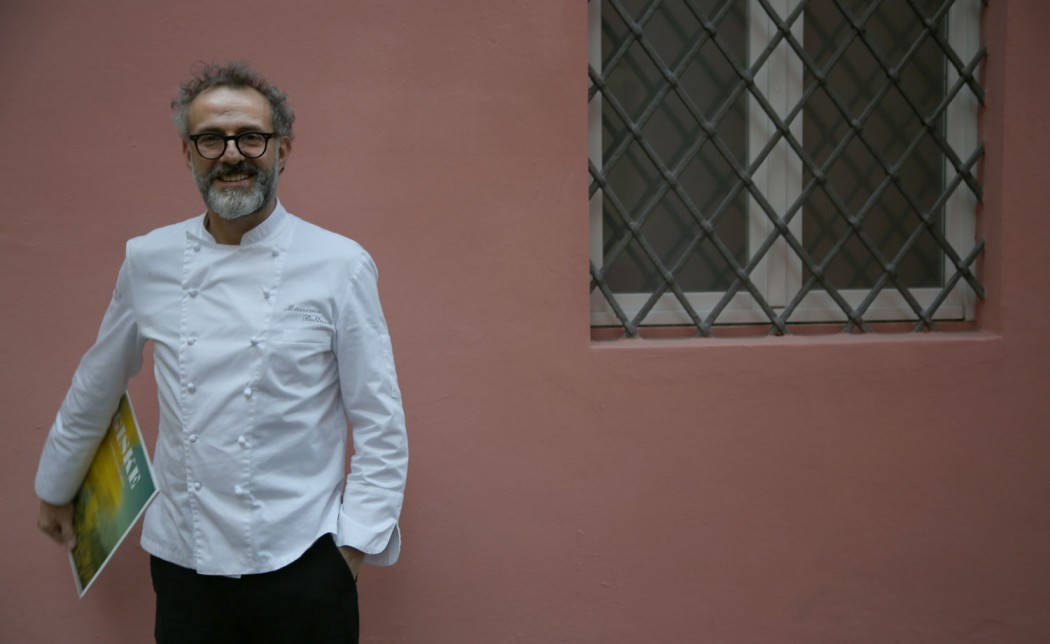

In order to achieve success you need to know everything and then forget it all, claims Massimo Bottura, one of the world’s best-known chefs and the man behind Osteria Francescana, a small establishment in the backstreets of Modena, with three Michelin stars and also ranked as the world’s second best restaurant on San Pellegrino’s prestigious The World’s 50 Best list.
Massimo’s own success can be attributed to several factors, but one of the most important things he’s brought to his cooking is his love of art and especially music. With absolutely no disregard to wonderful chefs such as Even Ramsvik (formerly of one Michelin star restaurant Ylajali), Esben Holmboe Bang (three star restaurant Maaemo), Kari Innerå (BA 53) and Nicolai Lundsgaard (head chef at the Royal Norwegian Castle) that have let me discuss their views on music with them, they all have some way to go before they reach the extreme passion that drives Massimo Bottura. His vinyl collection is estimated to include more than 12 000 records and he’s got the equipment to play them on.
– The first thing I do when I get up in the morning is to play music. It can be Monk or Keith Jarrett, I might put on an LP or just access Spotify on my mobile… When I return home from the restaurant and we’re done for the day… the same thing. I need music as a constant in my life. How can you not love music!
The last is not a question, but a statement, a truth of life.
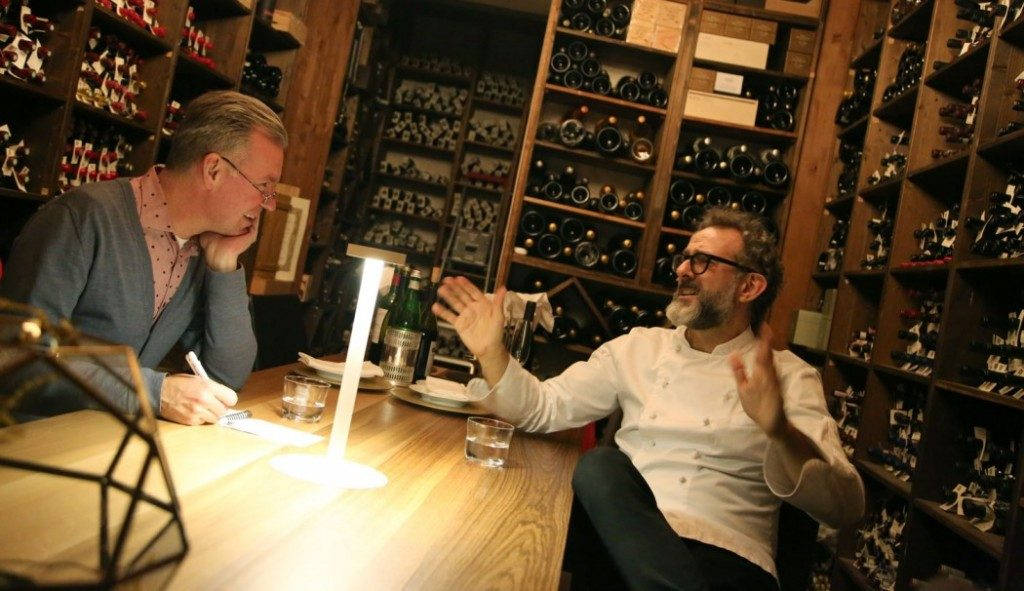
– I recognize people that love music from how they behave, how they react to a certain situation. I see what they’re like, that they have a deep sensibility. If you don’t like music…
And that’s where our conversation is disturbed. My wife Helle and I are in Modena, not only to meet Massimo Bottura, but first and foremost to eat his food. I’ve seen two television programs in the last year about Massimo and Osteria Francescana. One of them is part of the Netflix series Chef’s Table that follows six chefs in as many programs, Massimo amongst them, the second one is a less profiled but equally exciting program in which American chef and TV presenter Katie Button with a background from Ferran Adria’s legendary El Bulli restaurant visited a number of chefs in the series The World’s Best Chefs.
Both programs show Massimo Bottura as an extremely passionate man who enthusiastically conveys his thoughts and tells his story. Helle’s and my own big project since we saw these programs has been to secure a table at Osteria Francescana. It’s no easy task, but we did make it.
See also: All the dishes we had at Osteria Francescana
And here we are then, in the wine cellar of the restaurant, having just started the interview with Massimo when a head waiter shows two smiling lunch guests into the room in order for them to be photographed alongside the great man. Massimo is at his feet at once, making smalltalk with the couple and willingly posing for photos. It’s a situation in which he seems to be at total ease. This is a man who’s happy about his success, maybe especially so because he’s worked so hard to achieve it.
You see, Massimo Bottura’s great project has been to revolutionize the local cuisine. This is not something you do without meeting more than a fair share of resistance in Italy, nor in the region of Emilia Romagna or the town in which he was born, Modena. Osteria Francescana’s doors opened in 1995, and Massimo’s struggle to fulfil his vision was long and tough. Had it not been for the support from his American wife Lara, he might have given up, and he’s deeply grateful to her for helping him stand tall when the storm blew the fiercest. In 2002 Massimo received his first Michelin star, and from 2011 his restaurant has been ranked among the five best on the World’s 50 Best list.
In other words, everything is now hunky dory, and Massimo has achieved the acceptance he has long hoped and fought for. Today he is undisputedly a true superstar of the cooking world.
When he sits back down after receiving the praise of his lunch guests, he picks up from where he left by telling an anecdote about an art dealer he knows. – He’s very focused, very skilled, but I don’t think he actually loves art. He’s just a brilliant salesman.
That’s not what Massimo is attracted to. – Music is such a deep source of inspiration to me. Listen to Coltrane and his Caribbean influences exploring his own roots. Or Thelonious Monk, Dizzy Gillespie or Charlie Parker – all of them creative spirits. They are often weak, and they’re vulnerable, but they are creative, artistic people.
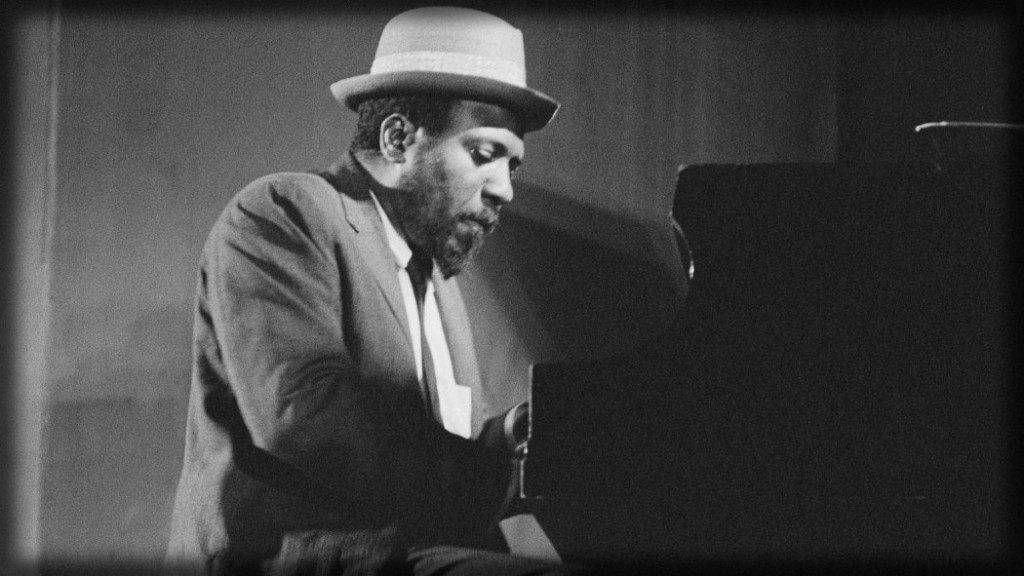
– A chef is not an artist, but an artisan. I don’t regard myself as an artist at all, simply because an artist can do what he wants. We chefs cannot. We can’t allow ourselves that kind of freedom. We have to make good food, he stresses.
But a chef can follow many structures similar to what we find in a piece of art, in a piece of classical music or a novel?
– Oh yes! A meal can be constructed just like an opera with overtures and so forth. Or like a beautiful house. You enter a hall, and from there you walk further inside the house and see different rooms with different functions. Some might be rooms that…
All of a sudden Massimo is back on his feet.
– Follow me, there’s something I need to show you. Bring the camera!
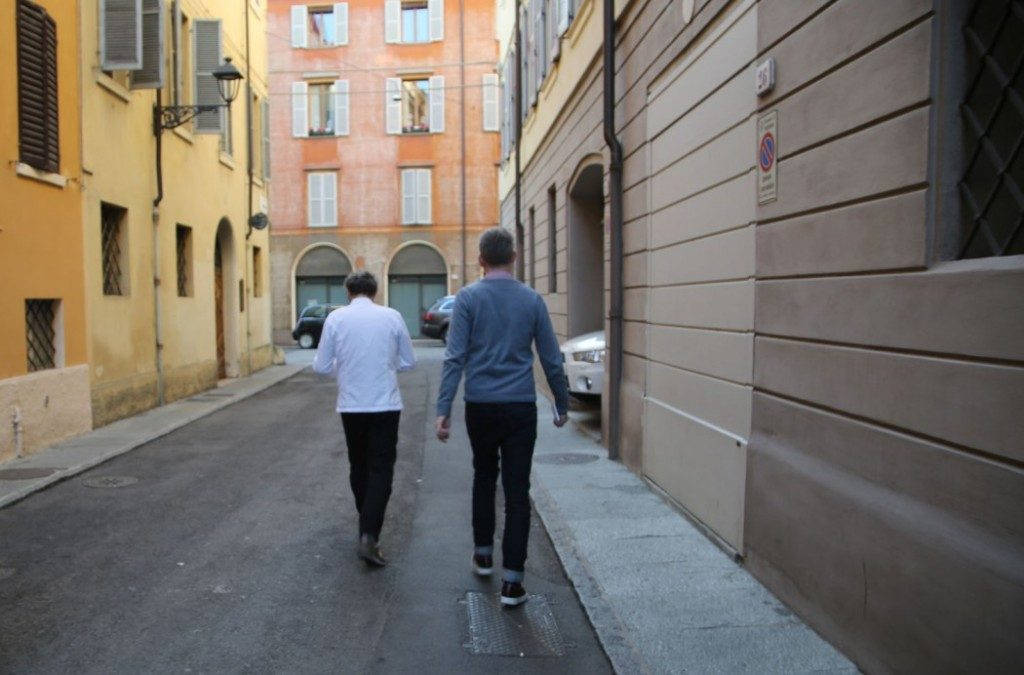
We rush out of the wine cellar and into the kitchen, past twenty or so cooks and apprentices, out into the lobby where waiters and head waiters mill about. From somewhere he’s found a chain of keys, and we’re outside the restaurant, walking down to the end of Via Stella and around the corner to Rua Muro where he unlocks a door, all the while talking about how he’ll show us something to make us understand. – I can’t convey something if I’m not being understood.
Massimo keeps talking up a storm, and as we enter his office, we’re shocked to find ourselves face to face with an American security guard standing upright inside a wooden crate. It’s a newly purchased piece of art by Dwayne Hanson who was famous for his very life-like sculptures, and this security guard is a person that Massimo describes as «a negative person», i.e. a person you don’t notice. – He’s just there, like part of the backdrop. Being present is his only function, but he’s just as important as anyone or anything else. There are so many people in the world that are not recognized for what they do, and this is the kind of person you can pass a million times and not notice. But when you put the same person in a new setting he’s all of a sudden being seen, Massimo explains enthusiastically.
I can vouch for the truth in that. The security guard will be placed right inside the door of the restaurant where you cannot possibly miss him.
– Do you understand? He’s a totally essential being, but nobody sees him. And here! This is another new piece I will put in the restaurant.
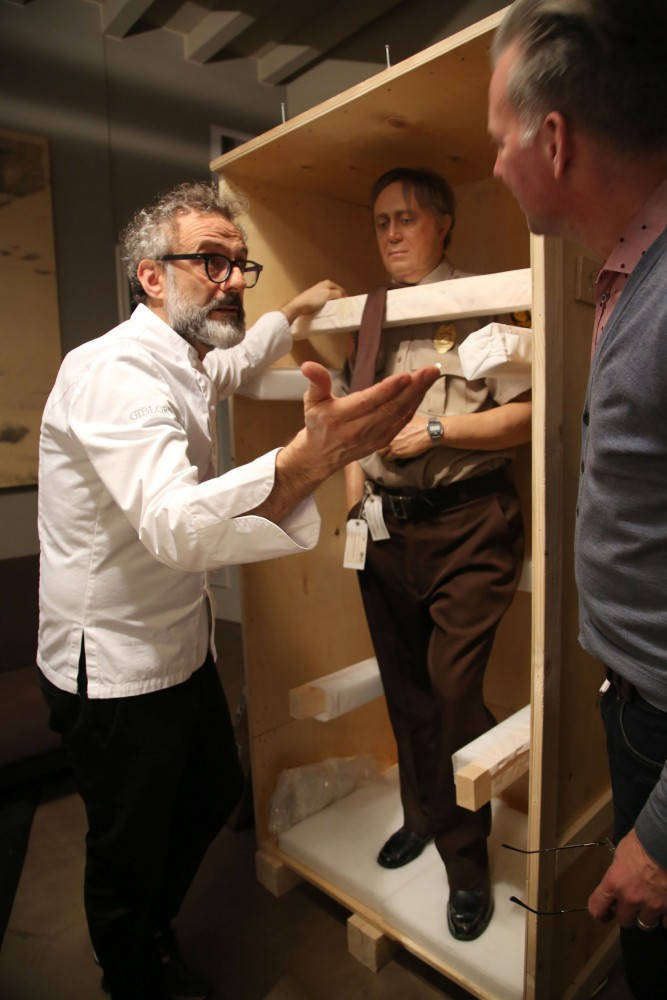
Partly hidden by clingfilm, in another crate we see a big, black, round shape.
– This is the earth, the black earth. This is what will happen if we don’t stop what we’re doing, says Massimo, waving his arms and revealing a deepfounded worry for the fate of the earth. – You are the first to see these objects, he says.
The black earth was made by the famous Mexican artist Bosco Sodi. Massimo is an eager art collector, and his understanding of and interest in art was awoken by Lara. The two met in New York when Massimo moved there in 1993 where he stayed for about a year and they worked at the same place. The two of them talk about their shared history, their time in New York and the difficulties towards what they’ve achieved in the Chef’s Table program.
Back in the wine cellar after Massimo has made his point, it’s time for him to tell of how his love for music began. What is his first memory of music?
– That must have been Pavarotti, he says after pondering the question for some time. – My family listened to a lot of opera. And my brother was crazy about Beethoven. We were five brothers and a sister, but the one who really made a difference was my closest brother Paolo. He introduced me to rock’n’roll. It was thanks to him that I got to know American folk music, Southern rock, Dylan… that’s where it all started for me.
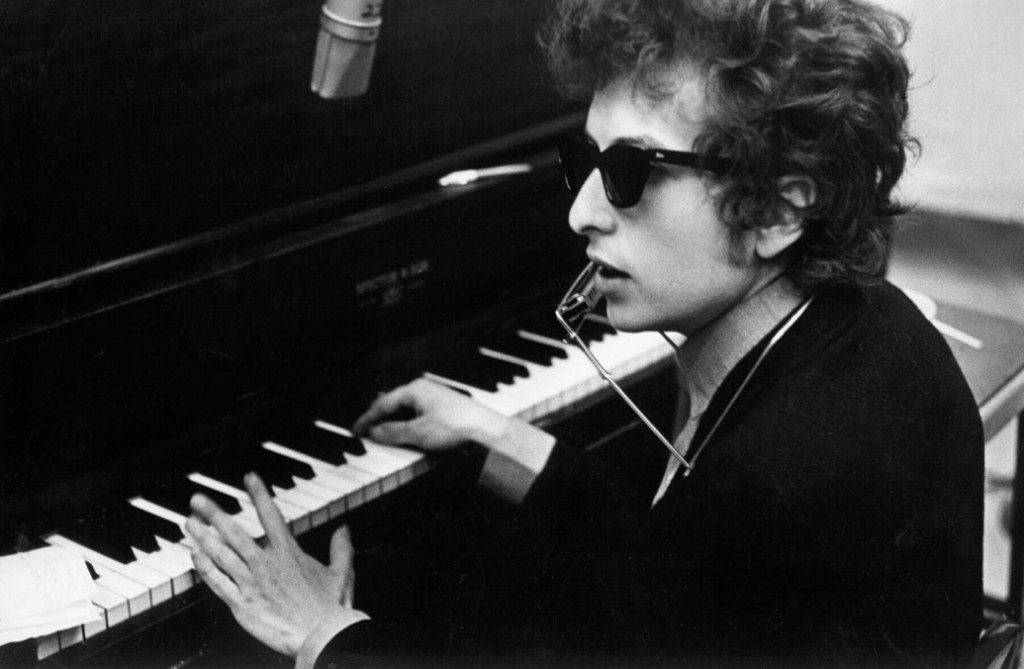
I’ve been reading up on Massimo’s musical preferences, and a clear majority of the acts he seems to like are American. When asked about this he misunderstands me.
– Yes, the language of rock’n’roll is English. I can’t listen to rock in Italian, it’s too romantic. Rock is more direct, and to hear rock’n’roll in Italian, or in Spanish, it’s just cheesy.
My other observation – that quite a few of the artists he likes had their heyday a long time ago – is not misunderstood.
– I listen to a lot of new music, don’t worry. I love keeping up with what’s happening.
He accesses Spotify on his iPhone, and what appears are a lot of younger acts as well as the older ones: James Bay, Kaleo, Vance Joy, Iron & Wine, Old Crow Medicine Show, Fleet Foxes, The Tallest Man On Earth, Carolina Chocolate Drops, The Postal Service and several others.

Massimo further talks about how his intellectual approach to music is what makes him capable of making the food he’s become known for. – It would have been impossible to make that kind of food if I didn’t have such a strong bond to music or art as such. It’s all about understanding what you do on an intellectual level.
We go on to talk about acts he likes, and he tells me that he considers a band such as R.E.M. as «more intellectual» and therefore «cooler». – The Cure is another band I truly love, but I consider them to be a pop band. David Byrne and Talking Heads on the other hand? Something altogether different.
These statements are made completely devoid of affection or arrogance, he even smirks at himself. It’s just the way he is.
– By the way, Michael Stipe is a great gourmet and a great guy.
Stipe and the rest of R.E.M, are among the many artists who have eaten his food in Osteria Francescana. Other notables to have been his guests are Lou Reed, Jackson Browne and David Byrne.
– Lou Reed was amazing. We spent four days together and he understood my passion. Late one night I was upset and screaming, complaining about how nobody understood a dish I had made and feeling sorry for myself. This was after a lot of food and alcohol, and I let my emotions run free. After a while Reed put up a hand and stopped me, turned to his guitar player and told him: «This is obsession. He’s got the same obsession with food that I have with amplifiers.»
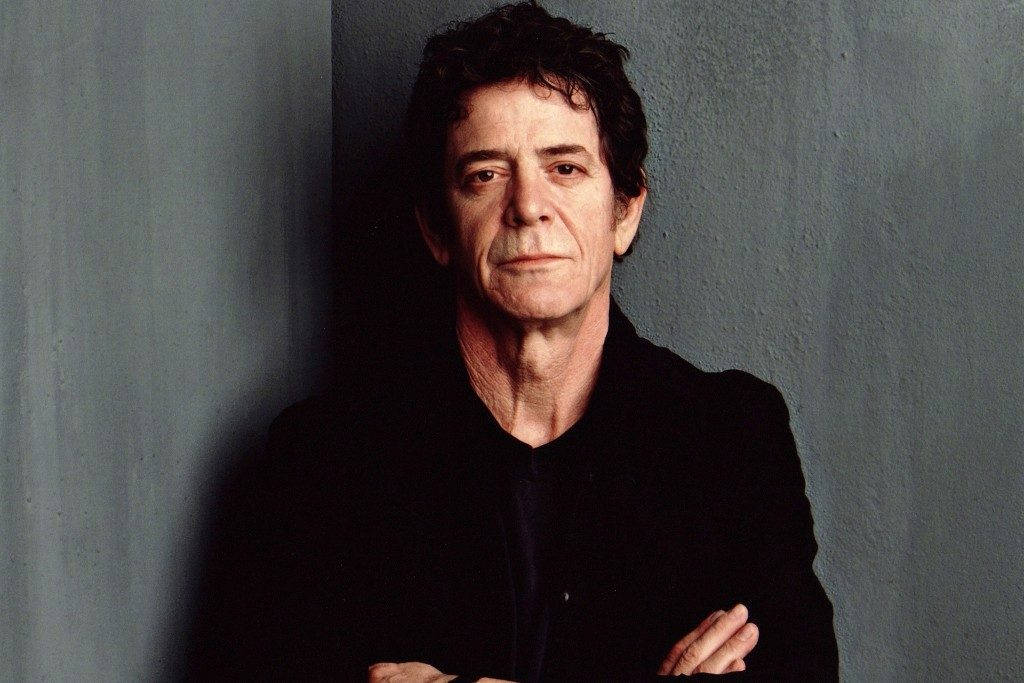
– Jackson Browne was an early discovery. I’m a huge fan. He meant more to me than Springsteen although I’m very fond of him too. This was in the 70’s, when Europe was beset with terrorism. A lot of American acts stopped touring here, but when I was about 16 or 17 some friends and I went on a bus to Lyon to see Springsteen, skipping school. Still, I’m even more fond of Jackson Browne.
– He’s the more intellectual of the pair, I suggest.
– Yes, there is that.
– And I wish I had met Van Morrison, Massimo eagerly continues and tells us how he saw three shows on three consecutive nights in Milan in 1980. – I had to see all three in order to get the big picture.
It doesn’t take a lot of effort to get Massimo Bottura going. He’s eager, passionate, enthusiastic, one hundred percent present and at the same time not at all. He’s unable to sit still for more than a few seconds at a time, almost shaking from restlessness, rocking back and forth on his chair, while his legs continuously follow a beat only he can perceive. He tells of great concerts like the time when he saw Rickie Lee Jones and Tom Waits perform in 1982 after Italy beat Western Germany in the World Championship in soccer (another passion for you there), how he saw David Bromberg with about 20 others (– He played just for us!), an intense Blasters show, and an even more intense Dead Kennedys concert in San Francisco in 1979 or 1980. – It was absolutely crazy, really dangerous, arms and legs everywhere, people going mad all around me, but with an incredible energy.
These are all experiences he’s brought to the way he cooks, and into Osteria Francescana. Does he play a lot of music in the restaurant kitchen?
– Of course! At the time we mostly use two very different playlists. There is one with younger acts like Beirut and Bon Iver, the other is mostly old blues stuff, Ma Rainey, John Lee Hooker and so on.
– And you’re the DJ?
– That’s right. I’m the one who decides what to play. There have been times when the young apprentices have been playing stuff, and I have had to ask them if they actually know that they listen to an old Marvin Gaye song. What’s the point in that when you can hear the original version? So I put that on instead.
– You educate them in this field as well?
– Yes, and luckily they let me!
It’s time to give something back to Massimo for his hospitality. I have brought him a gift, the debut album of a Norwegian pop trio named Giske, founded on the remains of now disbanded The Margarets.
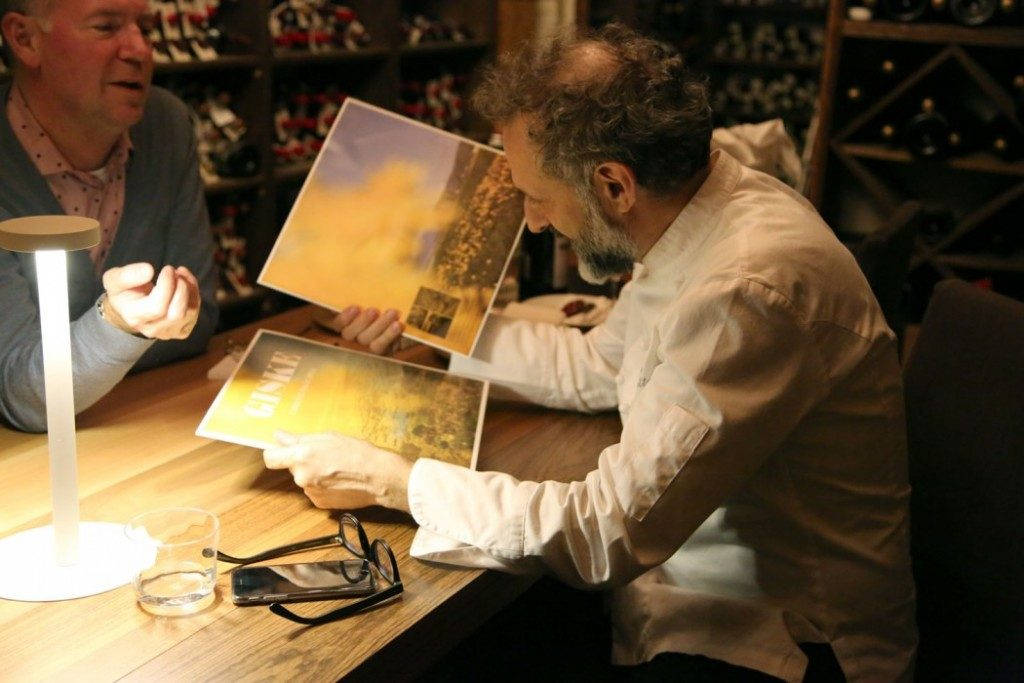
– Oh, wow! These are the best presents, Massimo exclaims, becoming like a small child at Christmas time. I’m going on to tell Massimo about how Giske’s percussionist Ronnie MAG Larsen and myself went to the Abbey Road Studios in London to «cut» the record for vinyl. Here we were met by the world’s leading Beatles engineer, Sean Magee, and was working in the same room in which The Beatles themselves cut their records, on the same mixing table that Pink Floyd used when cutting Dark Side Of The Moon.
See also: Our trip to Abbey Road
– Really? What a wonderful experience that must have been, an enthused chef says, and it looks like he’s really happy with the gift. You can’t fake this kind of enthusiasm.
Asked if he likes Norwegian bands like for instance Motorpsycho or Kings Of Convenience who are both well-known in Italy, he smiles broadly. He’s especially fond of Kings Of Convenience, and can’t really say enough nice things about them. One of the girls working in his office almost swoons with joy when a little later he tells her we have been talking about them. There is really no doubt about the duo’s standing here in Italy.
It comes as absolutely no suprise that we during our dinner later in the evening hear music seeping out from invisible speakers in the simply decorated restaurant. Neither sound level nor adrenaline overwhelm the gastronomic sensations, but we are listening to the great masters of popular music: Thelonious Monk, Frank Sinatra, Bessie Smith, Miles Davis and so forth – American legends of jazz and blues.
Towards the end of the meal Massimo himself enters the restaurant floor, easily moving from table to table, chatting for a few minutes with the guests at each of them. When he comes to our table, he looks us straight in the eyes and confirms: «Now you understand.»
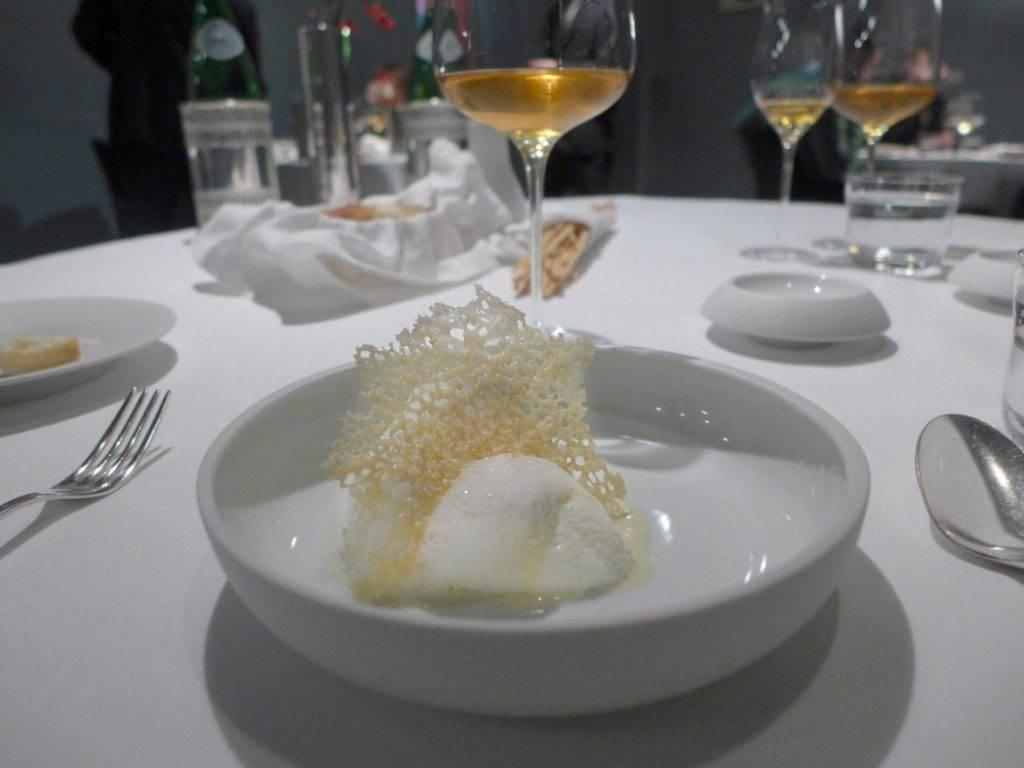
Yes, we do. Having enjoyed a meal at Osteria Francescana we understand more about Massimo Bottura’s vision and the passion that compliments it, about how his great interest in art and the way he sees connections form all the plates that are brought out from the kitchen: «Guitar string pasta with charred amberjack and smoked green tomato», «Autumn in New York», «Five Ages of Parmeggiano Reggiano in different temperatures and textures» and a further nine perfectly executed dishes carrying exciting names. And if Massimo himself does not dare call himself an artist, we can. At the very least he’s an amazing artisan, but to us there is no doubt. This is food as art.
I also had the pleasure of inviting Massimo to compile a playlist with a few of the songs that have meant the most to him. Listen to it below, in either Tidal or Spotify.
